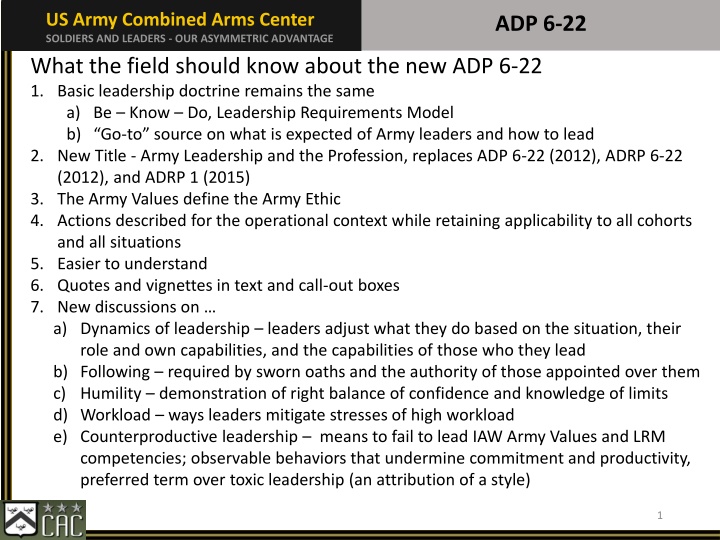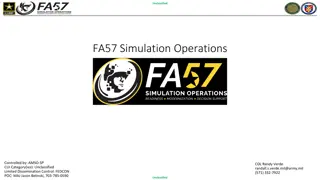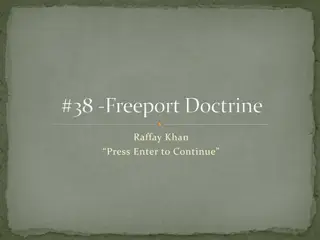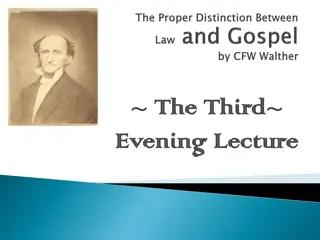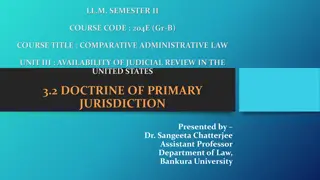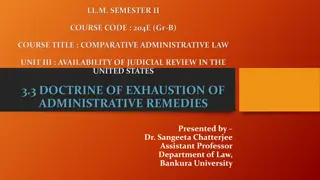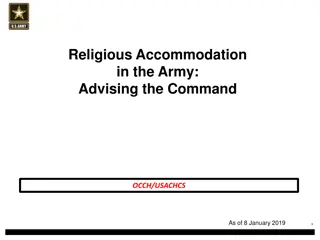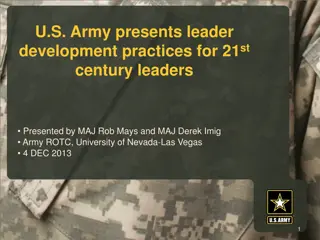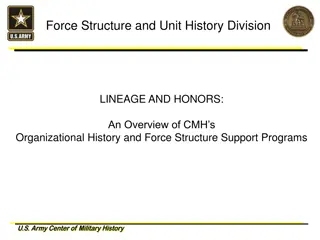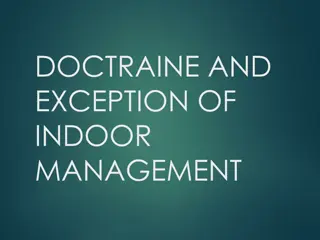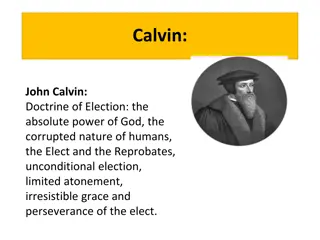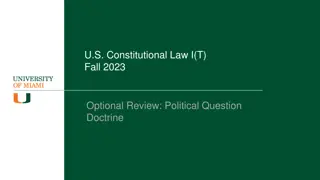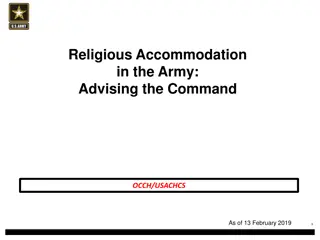Army Leadership Doctrine Update: ADP 6-22.1 Highlights
New Army Doctrine Publication (ADP) 6-22.1, "Army Leadership and the Profession," emphasizes the foundational principles of leadership with updated content and guidance. It covers essential leadership traits, values, competencies, and behaviors, providing insights into effective leadership practices for all Army leaders. The publication focuses on adapting leadership approaches based on situations, emphasizing humility, workload management, and countering counterproductive leadership behaviors. This updated doctrine aims to enhance Army leaders' understanding and application of leadership in various contexts.
Download Presentation

Please find below an Image/Link to download the presentation.
The content on the website is provided AS IS for your information and personal use only. It may not be sold, licensed, or shared on other websites without obtaining consent from the author.If you encounter any issues during the download, it is possible that the publisher has removed the file from their server.
You are allowed to download the files provided on this website for personal or commercial use, subject to the condition that they are used lawfully. All files are the property of their respective owners.
The content on the website is provided AS IS for your information and personal use only. It may not be sold, licensed, or shared on other websites without obtaining consent from the author.
E N D
Presentation Transcript
US Army Combined Arms Center SOLDIERS AND LEADERS - OUR ASYMMETRIC ADVANTAGE What the field should know about the new ADP 6-22 1. Basic leadership doctrine remains the same a) Be Know Do, Leadership Requirements Model b) Go-to source on what is expected of Army leaders and how to lead 2. New Title - Army Leadership and the Profession, replaces ADP 6-22 (2012), ADRP 6-22 (2012), and ADRP 1 (2015) 3. The Army Values define the Army Ethic 4. Actions described for the operational context while retaining applicability to all cohorts and all situations 5. Easier to understand 6. Quotes and vignettes in text and call-out boxes 7. New discussions on a) Dynamics of leadership leaders adjust what they do based on the situation, their role and own capabilities, and the capabilities of those who they lead b) Following required by sworn oaths and the authority of those appointed over them c) Humility demonstration of right balance of confidence and knowledge of limits d) Workload ways leaders mitigate stresses of high workload e) Counterproductive leadership means to fail to lead IAW Army Values and LRM competencies; observable behaviors that undermine commitment and productivity, preferred term over toxic leadership (an attribution of a style) ADP 6-22 1
ADP 6-22 Army Leadership and the Profession key ideas US Army Combined Arms Center SOLDIERS AND LEADERS - OUR ASYMMETRIC ADVANTAGE Applies to all Army leaders all the time A trustworthy profession upon which the Nation relies Produces outcomes needed for winning in LSCO Combat power unifier and multiplier Be-Know-Do Leadership is influence Leadership involves a wide range of behaviors Leadership can be learned and improved Leader attributes enable discretionary application of leadership All leaders are also followers What leaders should NOT be and do: counterproductive Need to understand to apply in performance appraisals, development, assessment & counseling 2
ADP 6-22 Army Leadership and the Profession US Army Combined Arms Center SOLDIERS AND LEADERS - OUR ASYMMETRIC ADVANTAGE The Army: a shared legacy to defend the Nation s interests and its people Army Profession: society s trust that grants the Army relative autonomy with oversight Army Leadership: purpose, direction, and motivation to accomplish the mission and improve the organization Army Leadership Requirements Model: what leaders should be, know, and do Leader Attributes (Be and Know): Army Values, Empathy, Warrior Ethos/Service Ethos, Discipline, Humility, Military Bearing/Professional Bearing, Fitness, Confidence, Resilience, Mental Agility, Judgment, Innovation, Interpersonal Tact, Expertise Leadership Competencies (Do): Leads Others, Build Trust, Extends Influence, Leads by Example, Communicates, Prepares Self, Creates a Positive Environment, Develops Others, Stewards the Profession, Gets Results Dynamics of Leadership: adaptation based on the leader, the led, and the situation Roles and Levels of Leadership: similarities and difference by cohort and level Leadership in Practice: special considerations during mission preparation and execution Organizational Leadership: plans and synchronizing actions executed through subordinates Strategic Leadership: shaping actions that set conditions for current and future success 3
US Army Combined Arms Center SOLDIERS AND LEADERS - OUR ASYMMETRIC ADVANTAGE ADP 6-22 Terms The Army Profession is a vocation of Soldiers and DA Civilians whose collective expertise is the ethical design of, support to, and application of landpower; serving under civilian authority; and entrusted to defend the Constitution and the rights and interests of the American people. Leadership is the activity of influencing people by providing purpose, direction, and motivation to accomplish the mission and improve the organization. An Army leaderis anyone who by virtue of assumed role or assigned responsibility inspires and influences people by providing purpose, direction, and motivation to accomplish the mission and improve the organization. Counterproductive leadershipis the demonstration of leader behaviors that violate one or more of the Army's core leader competencies or Army values, preventing a climate conducive to mission accomplishment. 4
US Army Combined Arms Center SOLDIERS AND LEADERS - OUR ASYMMETRIC ADVANTAGE ADP 6-22 Logic Map Influence for mission and organization Army profession An Army demonstrating character, competence and commitment establishes trust with the Nation to allow the Army to operate autonomously with prudent oversight Desired leader characteristics An element of combat power - Unifies and multiplies other elements Relation to Command LSCO Multiple Outcomes 5
ADP 6-22 Army Leadership and the Profession US Army Combined Arms Center SOLDIERS AND LEADERS - OUR ASYMMETRIC ADVANTAGE Competencies used in the model of leadership since 2006 Competency development Designed to guide develop- ment, performance, administration Incorporated historical trends and review of combat success Analysis of 200 skills sorted into set of competencies Guided by panel of top experts in leader performance Review & approval by Army LD stake-holders 3 rounds of Army-wide staffing Continual validation Comprehensive favorable comparison to other models 6
